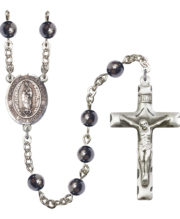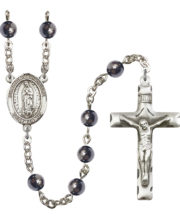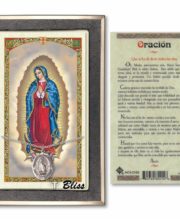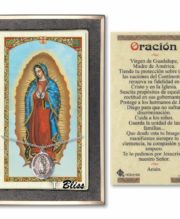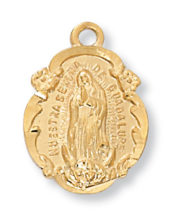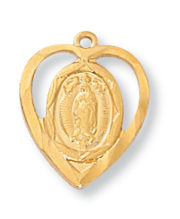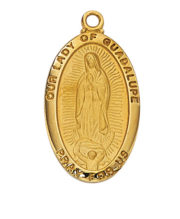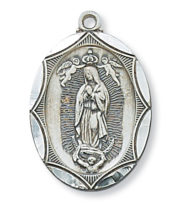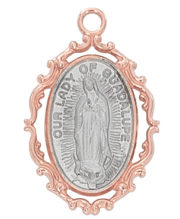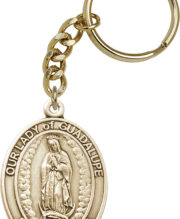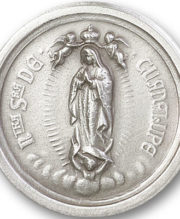Mary
Our Lady of Guadalupe
What is the Feast of Our Lady of Guadalupe
Our Lady of Guadalupe is one of the most beloved and revered religious figures in Mexico and throughout the Catholic world. The story of Our Lady of Guadalupe begins in December of 1531, when a poor indigenous peasant named Juan Diego was walking through the hills near Mexico City. As he walked, he heard a voice calling out to him from the top of a nearby hill.
Juan Diego climbed the hill to find a beautiful woman standing there, who identified herself as the Virgin Mary. She told Juan Diego that she wanted a church to be built on that spot, and that she wanted him to go to the local bishop to tell him of her wishes.
Juan Diego went to the bishop and told him of the vision, but the bishop was skeptical and asked for proof. The Virgin Mary then appeared to Juan Diego again and told him to gather roses from the top of the hill, even though it was December and the roses should not have been in bloom.
Juan Diego returned to the bishop with the roses, and when he opened his cloak to show them to the bishop, the image of the Virgin Mary was miraculously printed on the cloth. The bishop was convinced and ordered the construction of a church on the site of the vision.
The church was named the Basilica of Our Lady of Guadalupe, and it became a major pilgrimage site for Catholics from all over Mexico and beyond. Millions of people have visited the church over the centuries, and the image of Our Lady of Guadalupe on Juan Diego’s cloak has been venerated as a sacred object.
Over time, Our Lady of Guadalupe has come to be seen as a symbol of hope and unity for the people of Mexico. She is often depicted as a dark-skinned woman, which is believed to represent the indigenous people of Mexico, and her image is a powerful symbol of the blending of cultures and religions in Mexico.
Today, Our Lady of Guadalupe is celebrated on December 12th as a national holiday in Mexico, and the Basilica of Our Lady of Guadalupe is one of the most visited Catholic shrines in the world. The story of Our Lady of Guadalupe continues to inspire and guide people of all backgrounds, and her message of love and compassion remains as powerful today as it was in 1531.
Who was Juan Diego
Juan Diego was born in 1474 in Mexico and was a member of the Aztec people. He was a devout Catholic convert and was known for his strong faith and devotion to God. In December 1531, while on his way to Mass, Juan Diego had a vision of a young woman who identified herself as the Virgin Mary. She asked him to build a church in her honor on the site where they had met.
Juan Diego conveyed the message to the local bishop, but was initially met with skepticism. The Virgin Mary appeared to Juan Diego again, this time leaving an image of herself on his cloak, known as the tilma. When Juan Diego presented the tilma to the bishop, the image of the Virgin Mary was miraculously imprinted on it.
The bishop was convinced of the authenticity of the vision and ordered the construction of the Basilica of Our Lady of Guadalupe, which was completed in 1709. The tilma is still venerated as a sacred relic and is on display in the basilica.
Juan Diego’s devotion to the Virgin Mary and his role in the construction of the basilica led to him being considered a Saint by the Catholic Church, and was canonized by Pope John Paul II in 2002. The feast day of Saint Juan Diego is celebrated on December 9.
History of the Devotion to Our Lady of Guadalupe
The devotion to Our Lady of Guadalupe is a deeply ingrained aspect of Catholic faith in Mexico and beyond. It centers around the belief that the Virgin Mary, the mother of Jesus, appeared to a peasant named Juan Diego in 1531 on the hill of Tepeyac in what is now Mexico City. According to the story, Mary appeared to Juan Diego as a young, dark-skinned woman and spoke to him in his native Aztec language. She asked that a church be built on the hill in her honor, and as proof of her appearance, she left behind an image of herself on the cloak that Juan Diego was wearing. This image is now known as the Tilma of Our Lady of Guadalupe and is kept in the Basilica of Our Lady of Guadalupe in Mexico City.
The story of Our Lady of Guadalupe quickly spread throughout the region and beyond, and the site of the apparition became a popular pilgrimage destination. Many people, both indigenous and Spanish, began to visit the site in order to pray and seek blessings. Over time, the basilica was built at the site of the apparition, and it became one of the most important pilgrimage sites in the Catholic Church.
The devotion to Our Lady of Guadalupe is closely linked to the history of Mexico, particularly to the period of the Spanish conquest. Many indigenous Mexicans saw the apparition of Our Lady of Guadalupe as a sign of the acceptance of Christianity by their own culture and a symbol of the unity between the indigenous and Spanish cultures.
One of the unique aspects of the devotion to Our Lady of Guadalupe is the image of the Virgin Mary that appeared on the tilma of Juan Diego. The image is unusual in that it shows the Virgin Mary with dark skin, similar to the appearance of the indigenous Mexicans. This helped to further the acceptance of Christianity among the native peoples and helped bridge the gap between the Spanish and indigenous cultures.
The feast day of Our Lady of Guadalupe is celebrated on December 12th. On this day, Catholics gather at the basilica to pray, sing hymns and attend mass in honor of Our Lady. Many people make a pilgrimage to the basilica on this day, sometimes traveling from great distances. This event is particularly popular in Mexico, where it is a national holiday and many activities are organized across the country
The devotion to Our Lady of Guadalupe is also spread by the Missionaries of Our Lady of Guadalupe. They are a group of lay and clerical who travel around the world, spreading the message of Our Lady of Guadalupe and promoting devotion to her. They also promote the Hispanic culture, it´s values and traditions.
The devotion to Our Lady of Guadalupe is not limited to Mexico and Mexican communities. It is also popular among Catholics of all backgrounds, including those in the United States and other parts of the world. Many churches and shrines dedicated to Our Lady of Guadalupe can be found in cities with large Hispanic populations, such as Los Angeles and Chicago.
In conclusion, devotion to Our Lady of Guadalupe is a strong and central aspect of Catholic faith in Mexico and among Mexican communities worldwide. It centers around the belief that the Virgin Mary appeared to a peasant named Juan Diego in 1531 on the hill of Tepeyac in what is now Mexico City, and it has played an important role in the history of Mexico. Many indigenous Mexicans saw the apparition of Our Lady of Guadalupe as a sign of the acceptance of Christianity by their culture and as a symbol of unity between the indigenous and Spanish cultures. December 12th, the Feast day of Our Lady of Guadalupe is a national holiday in Mexico and it is celebrated by Catholics around the world.
Papal Writings about Our Lady of Guadalupe
Several popes have written about Our Lady of Guadalupe and her significance. Pope John Paul II, during his papacy, had a strong devotion to Our Lady of Guadalupe, and he visited the Basilica of Our Lady of Guadalupe in Mexico City twice during his pontificate. In 1999 he wrote an apostolic letter, “Nuestra Señora de Guadalupe, Madre de América,” in which he reflected on the meaning of the image of Our Lady of Guadalupe and its role in the history of the Americas. He wrote that the image is a symbol of the “encounter between the Virgin Mary and the first evangelizers, as well as the meeting of European and indigenous cultures.”
Pope Francis also wrote about Our Lady of Guadalupe in his 2015 apostolic exhortation “Evangelii Gaudium” where he states “In America, the Virgin of Guadalupe has a special significance. She is a symbol of the encounter between the Gospel and the cultures, a sign of the incarnation of God’s word and of the unity of all peoples in Jesus Christ.”
Pope Benedict XVI also wrote about Our Lady of Guadalupe in his 2007 apostolic exhortation “Sacramentum Caritatis” where he states “The Virgin of Guadalupe has become a symbol of the Church in America and a powerful expression of the Gospel’s inculturation in America. The devotion to Our Lady of Guadalupe is a sign of the Church’s vitality in America, and it is a powerful testimony to the Gospel’s power to transform culture.”
History of the Basilica of Our Lady of Guadalupe
The Basilica of Our Lady of Guadalupe is a Catholic church located in Mexico City, Mexico. It is built on the site where the Virgin Mary is said to have appeared to Juan Diego Cuauhtlatoatzin, an indigenous Mexican convert to Catholicism, in 1531.
According to the story, in December of 1531, Juan Diego was on his way to Mass when he had a vision of a young woman, who identified herself as the Virgin Mary. She asked him to build a church in her honor on the site where they had met. Juan Diego conveyed the message to the local bishop, but was initially met with skepticism. The Virgin Mary appeared to Juan Diego again, this time leaving an image of herself on his cloak, known as the tilma. When Juan Diego presented the tilma to the bishop, the image of the Virgin Mary was miraculously imprinted on it.
The bishop was convinced of the authenticity of the vision and ordered the construction of the Basilica of Our Lady of Guadalupe. The first church was a small, thatched-roofed structure built in 1531-1532. It was replaced in the 16th century by a larger church, which was later expanded and renovated several times. The current basilica was completed in 1976 and is considered one of the most visited Catholic pilgrimage sites in the world.
The basilica complex includes several chapels, a museum, and a library. The main attraction is the tilma of Juan Diego, which is on display in the basilica. The image on the tilma is said to be miraculously preserved, despite being made of a coarse cactus-fiber cloth that should have deteriorated in 20 years.
Today, the Basilica of Our Lady of Guadalupe is a major pilgrimage site for Catholics from around the world, and it is estimated that around 20 million people visit the basilica each year. It is also a symbol of Mexican identity and a source of inspiration for many people, regardless of their religious beliefs.
Prayers to Our Lady of Guadalupe
Hail Holy Queen
Hail, Holy Queen, Mother of Mercy, our life, our sweetness, and our hope. To thee do we cry, poor banished children of Eve. To thee do we send up our sighs, mourning and weeping in this vale of tears. Turn then, most gracious advocate, thine eyes of mercy towards us, and after this our exile, show unto us the blessed fruit of thy womb, Jesus. O clement, O loving, O sweet Virgin Mary.
O Virgin of Guadalupe, Queen of the Angels and Mother of the Americas. We fly to your protection and beg for your intercession.
We implore your help in all our needs, especially for the grace to live as true disciples of your Son.
We ask you to help us in our daily struggles, to increase our faith and to deepen our love for Jesus Christ.
We entrust to you the salvation of all our brothers and sisters, especially for those who have lost their way.
O Mother of Mercy, we trust in your love and beg for your intercession.
Amen.
Lessons learned from Our Lady of Guadalupe
-
Faith in the face of skepticism: Juan Diego faced skepticism when he told the bishop of his vision of Our Lady of Guadalupe, but he persisted in his faith and was ultimately able to prove the validity of his vision through the miraculous image on his cloak.
-
Unity through diversity: Our Lady of Guadalupe is often depicted as a dark-skinned woman, representing the indigenous people of Mexico. Her image is a powerful symbol of the blending of cultures and religions in Mexico, showing that unity and understanding can be achieved through diversity.
-
The power of devotion: Millions of people have visited the Basilica of Our Lady of Guadalupe over the centuries, showing the powerful impact that devotion and pilgrimage can have on individuals and communities.
-
The importance of humility: Juan Diego was a poor indigenous peasant, yet Our Lady of Guadalupe chose him to be the messenger of her message. This teaches us that it’s important to be humble and that even the most unlikely person can be called to do great things.
-
The power of miracles: The image of Our Lady of Guadalupe on Juan Diego’s cloak is a powerful reminder of the power of miracles and the ability of God to work through unexpected means.
-
The importance of compassion: Our Lady of Guadalupe is often depicted as a nurturing and compassionate figure, reminding us of the importance of showing compassion and kindness to others.
-
The power of prayer: The story of Our Lady of Guadalupe began with a prayer by Juan Diego, and the power of prayer is evident throughout the story. It serves as a reminder of the importance of prayer in our lives.
-
The importance of listening: Juan Diego heard the voice of Our Lady of Guadalupe calling out to him, and he followed her instructions, reminding us of the importance of listening and being open to guidance and direction from above.
Medals and Pendants
Medals and Pendants
Medals and Pendants
Medals and Pendants
Medals and Pendants
Medals and Pendants
Auto Accessories
Auto Accessories


